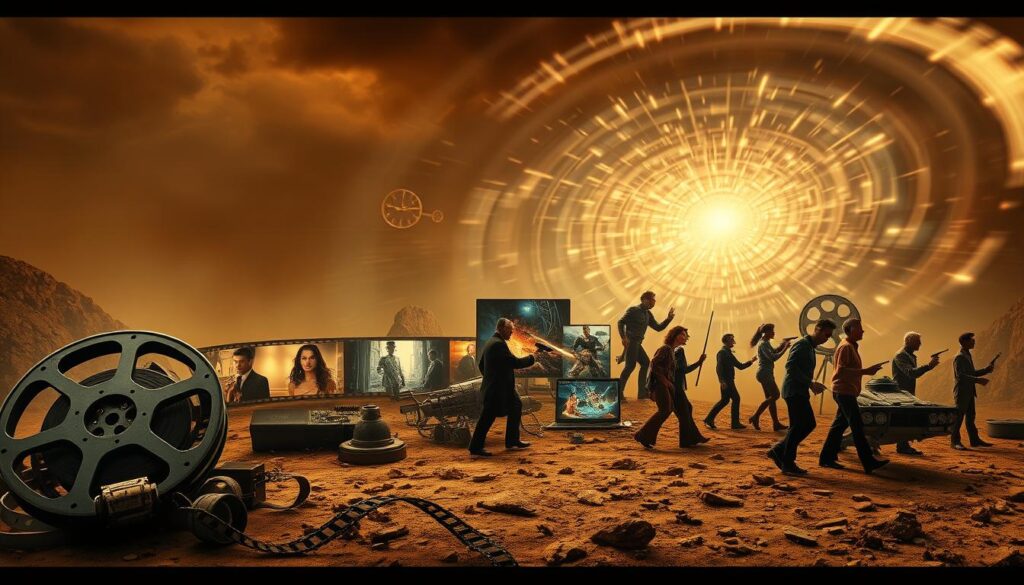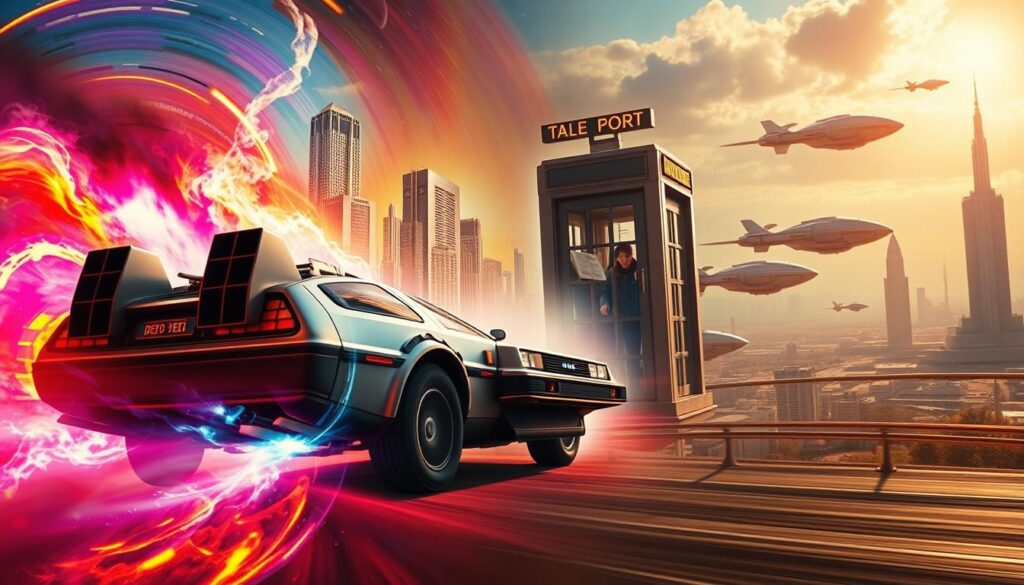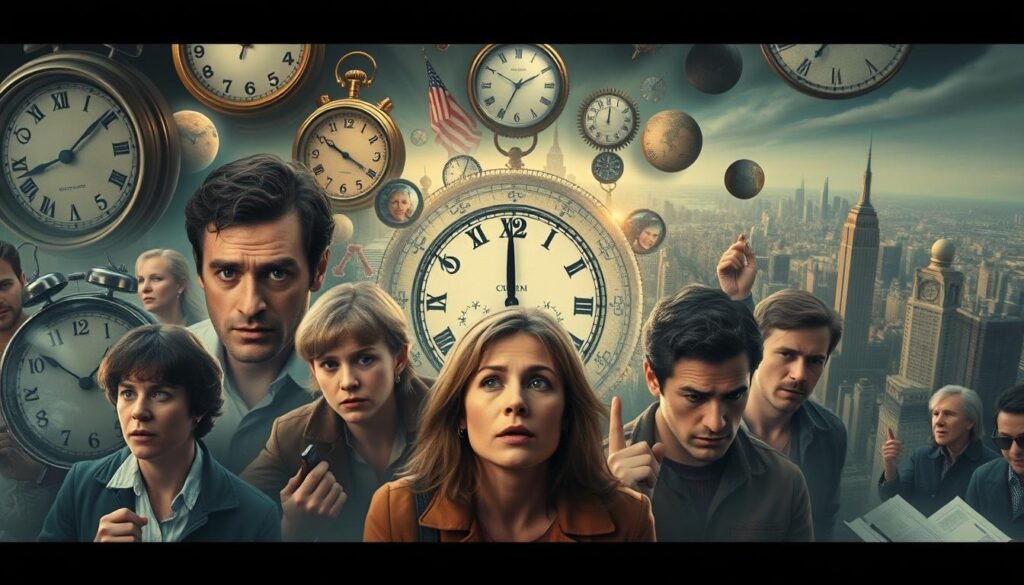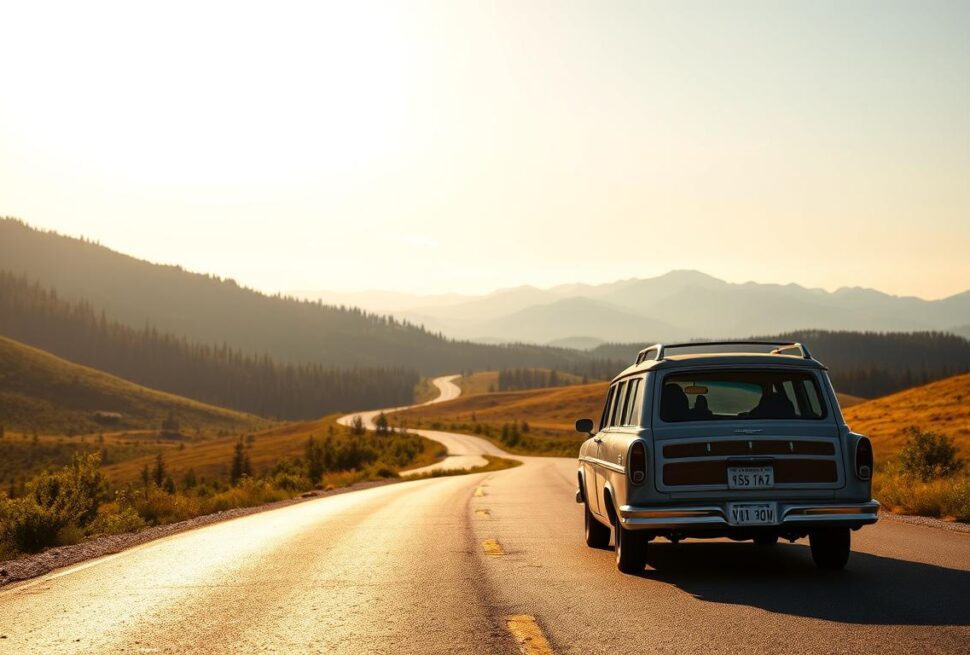Best Time Travel Movies
There’s something magical about stories that bend the rules of reality. I’ll never forget the first time a film made me question everything I knew about cause and effect how a single choice could ripple through decades or rewrite destinies. That’s the power of temporal storytelling, and it’s why I’ve spent months exploring every twist and turn this genre offers.
From tear-jerking dramas to adrenaline-pumping adventures, these narratives do more than entertain. They make us wonder: What if we could fix yesterday’s mistakes? Or glimpse tomorrow’s possibilities? Modern creators have transformed simple “what if” scenarios into rich explorations of human nature, blending science with raw emotion.
My journey through cinema history revealed surprises at every turn. Did you know one groundbreaking French production from 1962 laid the foundation for today’s complex plots? Or that romantic comedies can handle paradoxes as deftly as action-packed blockbusters? I’ve balanced timeless classics with underrated treasures that deserve your attention.
Key Takeaways
- Curated collection spans 60+ years of innovative storytelling
- Mix of genres includes romance, comedy, and mind-bending sci-fi
- Features both Hollywood hits and international hidden gems
- Explores four distinct approaches to temporal mechanics
- Perfect for family movie nights or deep-dive analysis
Whether you’re new to the genre or a seasoned fan, this guide will help you discover stories that stick with you long after the credits roll. Let’s explore how filmmakers have turned the past and future into their playgrounds – and maybe find your next favorite watch along the way.
Introduction: What Makes Time Travel Movies Timeless
When I first watched a science fiction classic where characters leaped between decades, it sparked a lifelong curiosity. These narratives aren’t just about clocks spinning backward – they’re mirrors reflecting our deepest questions about life’s what-ifs. Like flipping through a family photo album while planning tomorrow’s itinerary, they let us explore human connections across generations.
Why These Tales Resonate With Me
Growing up, I’d imagine conversations with historical figures or fast-forward to future breakthroughs. That’s the magic of temporal storytelling – it turns abstract concepts like destiny into personal journeys. Through layered plots, filmmakers transform theoretical physics into emotional rollercoasters where choices echo across centuries.
From Steam Engines to Quantum Leaps
Early films used clunky machines as plot devices, but modern entries dive deeper. A 1960s French masterpiece showed me how paradoxes could reveal societal truths, while recent indie projects use temporal shifts to dissect relationships. This evolution parallels our tech-driven world – where yesterday’s fantasy becomes tomorrow’s app feature.
What keeps these stories fresh? They let us critique modern issues through historical parallels or futuristic warnings. As one director told me: “Time distortion is just the vehicle – the real destination is the human heart.” That’s why we keep rewinding these tales, discovering new layers with each viewing.
History and Evolution of Time Travel in Film
Cinema’s fascination with temporal journeys began long before digital effects. My deep dive into film history revealed how storytellers first leaned on folklore and fantasy. Washington Irving’s 1819 tale of a man sleeping through revolution felt more like magic than science – a trend that dominated early narratives.

From early classics to modern masterpieces
Everything changed when H.G. Wells introduced his iconic time machine in 1895. This mechanical marvel became the blueprint for science fiction writers. Early filmmakers adapted these ideas, but struggled with limited technology. I still get chills watching 1962’s La Jetée – a French short told through still images that somehow feels more urgent than most modern blockbusters.
The 20th century brought Einstein’s theories into the mix. Suddenly, characters weren’t just jumping decades – they warped through space-time rifts. What fascinates me is how these complex concepts never overshadow human drama. Even when explaining quantum physics, the best stories keep emotional stakes at their core.
Today’s creators blend old-school charm with cutting-edge science. They’ve turned temporal journeys into mirrors reflecting our modern anxieties – climate change, AI, and fractured relationships. As one cinematographer told me: “We’re not just building machines anymore. We’re building bridges between what was and what could be.”
My Personal Journey into the World of Time Travel Cinema
My obsession began at 14, when a flickering TV screen showed characters rewriting history. That moment cracked open a door to infinite realities – one I’ve spent years exploring frame by frame. While many associate temporal adventures with Doctor Who or Lost, I found richer truths in cinematic stories that linger like unresolved paradoxes.
French New Wave experiments taught me how fractured timelines could mirror our fragmented memories. Blockbuster spectacles revealed how human connections persist across eras. Through midnight screenings and frame-by-frame analysis, I discovered each director’s unique approach – some treat temporal mechanics like puzzle boxes, others as emotional landscapes.
What keeps me hooked isn’t the technology, but how these narratives make me interrogate my own path. Could changing one conversation alter my relationships? Do parallel versions of me make braver choices? The most powerful stories use temporal displacement to ask universal questions about regret and hope.
Over two decades, I’ve watched the genre evolve from campy fun to profound philosophy. Modern creators weave quantum theory with intimate character studies, proving that temporal journeys work best when anchored in raw humanity. As a fellow fan once told me: “Great time travel cinema isn’t about escaping reality – it’s about confronting it through new lenses.”
Unmissable: Best Time Travel Movies
Few cinematic experiences capture the imagination like stories that twist temporal boundaries. Two legendary franchises stand as pillars of the genre – one a masterclass in storytelling, the other an ode to unbridled optimism. These aren’t just films; they’re cultural touchstones that shaped how we view temporal adventures.

Defining the genre with iconic films
The Back to the Future trilogy remains unmatched in balancing humor, heart, and scientific curiosity. Robert Zemeckis crafted Marty McFly’s journey as more than a DeLorean joyride – it’s a blueprint for intergenerational understanding. I’ve lost count of how many viewers discovered profound truths about family dynamics through its lightning-fueled escapades.
Then there’s the pure electric joy of Bill & Ted’s Excellent Adventure. Winter and Reeves transformed historical figures into comedy gold while sneaking in wisdom about collaboration. Their time-hopping antics prove temporal mechanics matter less than the friendships we nurture across eras.
What makes these stories endure? They treat temporal journeys as metaphors for personal growth. Whether navigating parental relationships or saving reality through rock music, these classics remind us that every moment holds infinite possibilities. As Bill and Ted would say: “Strange things are afoot at the Circle K!” – and cinema’s better for it.
Time Machines and Their Cinematic Magic
What transforms a prop into an iconic time machine? It’s the stories it enables, not the science it explains. Filmmakers have crafted everything from steam-powered brass gadgets to glowing orbs – each device reflecting our evolving relationship with possibility.
When Mechanics Meet Imagination
Time After Time reimagines H.G. Wells’ Victorian contraption as a plot catalyst. Instead of technical jargon, we get a cat-and-mouse game across eras. Malcolm McDowell’s Wells chasing Jack the Ripper through 1979 San Francisco proves temporal devices work best when fueling human drama.
Disney’s Meet the Robinsons takes a different approach. Its whimsical machines become tools for healing family bonds. The film’s message – “Keep moving forward” – resonates precisely because the technology serves emotional growth rather than cold science.
I’ve found the most memorable devices prioritize wonder over wiring. Whether it’s a souped-up DeLorean or a phone booth, their magic lies in transporting audiences, not explaining quantum mechanics. As one production designer told me: “People remember how a machine made them feel, not how it works.”
This philosophy explains why diverse designs thrive. Abstract concepts in indie films challenge our perceptions, while blockbuster vehicles become cultural symbols. The true machine? Storytelling that connects across generations.
Time Loops, Paradoxes, and Alternate Realities
Few narrative devices grip audiences like stories where characters relive moments endlessly. These plots turn frustration into fascination, letting us dissect life’s pivotal decisions through fictional lenses. What begins as a gimmick often reveals profound truths about resilience and self-discovery.

The narrative power of repeated moments
When Lola sprinted through Berlin in Run Lola Run, I realized how minor choices reshape entire worlds. Her crimson hair became a visual metronome, syncing with the film’s heartbeat-like rhythm. Director Tom Tykwer proves repetition isn’t redundancy – it’s a tool for showing growth through subtle variations.
Edge of Tomorrow sharpens this concept with military precision. Tom Cruise’s gradual transformation from coward to hero happens through accumulated experience, not sudden epiphanies. The editing tricks our brains into feeling déjà vu while still delivering fresh tension – a masterclass in balancing familiarity and surprise.
Exploring causal loops through films
Source Code haunts me with its ethical questions. Jake Gyllenhaal’s consciousness trapped in a digital echo asks: How many lives justify one sacrifice? The film’s ticking clock creates urgency, but its real magic lies in making us ponder our own moral equations.
Then there’s Palm Springs, where Andy Samberg turns existential dread into laugh-out-loud moments. The desert wedding loop mirrors pandemic-era stagnation, proving humor can coexist with deep philosophical musings. As Samberg’s character quips: “We’re not dying. We’re just… stuck.”
These stories work because they mirror our own cycles – habits we can’t quit, patterns we yearn to break. Through cinematic loops, we confront life’s messy beauty: progress isn’t linear, but every iteration brings us closer to who we’re meant to become.
Action-Packed and Adventurous Time Travel Flicks
Adrenaline meets intellect in films where temporal mechanics fuel explosive storytelling. These narratives prove you don’t need to sacrifice brains for brawn – the most thrilling journeys balance mind-bending concepts with heart-pounding stakes.
When the Clock Ticks Louder Than Bullets
Looper hooked me with its brutal elegance. Watching Joseph Gordon-Levitt confront his older self (Bruce Willis) isn’t just about cool shootouts. It’s a raw look at how our future selves might judge today’s choices. The film’s dystopian landscape becomes a character itself – one that asks uncomfortable questions about cycles of violence.
Christopher Nolan’s Interstellar redefined what space travel stories could achieve. Beyond the stunning black hole visuals lies a father-daughter bond stretching across dimensions. I still get chills during the library scene, where love literally transcends time travel physics.
What makes these action-driven tales work? They treat temporal elements as emotional amplifiers. Every jump between eras raises personal stakes, turning chase sequences into existential battles. As one director friend told me: “Great adventure isn’t about moving fast – it’s about making every second count.”
FAQ
Why do stories about altering timelines resonate across generations?
I think they let us explore “what if?” scenarios safely. By bending rules of cause and effect, films like Back to the Future or The Time Machine challenge our views on fate while sparking imagination.
How do filmmakers make fictional devices like a temporal transporter feel believable?
Creative teams blend pseudo-science with visual flair. For example, Star Trek uses warp theory, while Donnie Darko leans into eerie realism. It’s about grounding the impossible in relatable emotions.
Which titles handle paradoxes without confusing audiences?
A: Primer and Looper stand out. They simplify complex ideas through tight scripts and character-driven stakes. Even when logic bends, emotional truths keep viewers anchored.
Has cinema’s approach to temporal journeys changed over decades?
Early works focused on adventure, like H.G. Wells adaptations. Modern films, such as Interstellar, mix hard science with human drama. Tech advancements let directors visualize abstract concepts more vividly.
Any favorites that blend humor with high-stakes temporal chaos?
Absolutely! Edge of Tomorrow balances wit with relentless action, while Bill & Ted’s Excellent Adventure turns history into a playground. Both prove the genre doesn’t always take itself seriously.
What action-heavy picks use time manipulation uniquely?
A: Terminator franchises weaponize it for thrills, and Avengers: Endgame weaves it into superhero lore. These films prioritize momentum, using temporal shifts to amplify tension rather than dissect theory.




